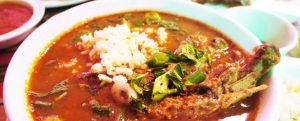Kak’ik
Background of food item/dish:
The food I have chosen is a Guatemalan dish by the name of Kak’ik. Although Kak’ik is not regarded as the national dish of Guatemala, it is still a meal that families commonly share. Unlike the other Guatemalan foods I conducted research on, this was something I had never heard of or tasted. Kak’ik is a turkey soup composed of puréed tomatoes, tomatillos, and garlic often served with chile paste and rice. There are a myriad of spices in Kak’ik, including coriander and achiote, that give it a renowned hot and peppery taste. I am looking forward to trying it for the first time in Guatemala.
Cultural perspective:
Kak’ik is served present-day as tradition when one moves into a new home; however, its roots have a deeper cultural meaning. History tells us that Kak’ik originated from the Q’eqchi’ Mayas of Guatemala. The origin of Kak’ik relates mostly to Dr. Tajali’s lecture on multicultural food because Kak’ik serves as the culinary cultural identity of the Q’eqchi’ Mayas of Guatemala. The preparation of Kak’ik included a ritual that is very important to the Q’echi’ culture and tradition. The ritual consists of killing, cleaning, and cooking the turkey. Although the way that Kak’ik is prepared today does not include the sacred rituals mentioned above, Guatemalan families still indulge in this delicious food to pay homage to their ancestors. The various vegetables included in Kak’ik are roasted over fire and then puréed using a grinding stone. At this time, one can even add their own selection of seasoning or spices. Turkey should then be added to the pot with the puréed vegetables and spices. Kak’ik takes approximately two hours to simmer over low heat and then it is ready to serve. In relation to Dr. Cochran and Dr. Scott’s lectures lecture, Kak’ik is mostly popular among indigenous populations, so there are no dominant corporate influences that impact the consumption of Kak’ik.
Socio-economic and political perspective:
Today, the Q’eqchi’ people of Guatemala remain the largest Mayan population in Guatemala, they also live in Belize, El Salvador, and Mexico. The approximate population of the Q’eqchi Mayas is 900,000, which indicates that they still have a significant presence today. Statistics tell us that approximately 40% of the Guatemalan population remains indigenous to this day, which includes the Q’eqchi Mayas. Financially speaking, Kak’ik is an affordable dish that can feed a small family for days or a large family all at once. The ingredients are not expensive or inaccessible due to the fact that many of the vegetables and spices included can be grown on one’s own land.
Environmental perspective:
As mentioned earlier, over 40% of the Guatemalan population remains indigenous, which conveys the idea that the environment has a very big impact on day-to-day routines and activities that take place within the Q’eqchi’ Maya populations. Preparing the Kak’ik involves a sacred ritual that glorifies the killing, cleaning, and cooking of the turkey. Although Kak’ik has no significant environmental presence, another notable fact about the Q’eqchi population is that their diet relies heavily on corn, a staple crop throughout Guatemala and Central America. It is also important to consider that Kak’ik is a environmentally sustainable dish due to the abundance of natural vegetables and spices. Perhaps other ingredients used in Kak’ik such as chiles and rice, have a larger environmental presence in Guatemala and the Q’eqchi people because they are also staple crops in Guatemala. In relation to Dr. Lovell’s lecture on climate change, it is important to consider that these Guatemalan staple crops in Guatemala could be harmed by climate change and make it harder to obtain many ingredients in traditional Guatemalan dishes.

